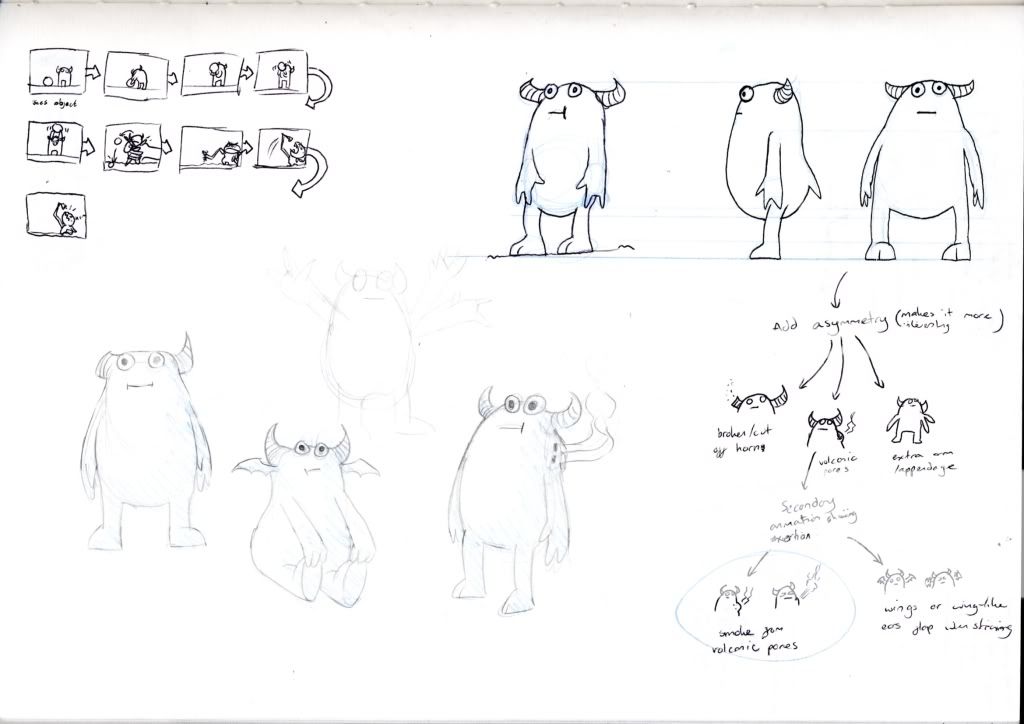Nice little centre bar I think.
Edit-
Experimental piece animatic
Mostly pixilation and stop-motion.
I need to do more tests with meat.
I finally have some sketches to show, I managed to find a working scanner to use.
So here goes:
Fentil sketches:

A small hunting pod of luminopticates seeing over a tile-top plain.

Dorsoplacates
Left: body stance and common leg arrangement.
Right: A dorsoplacate mating pair feed on a young cloverhead, while their offspring play and fight over morsels of flesh.
Dosroplacates are hermaphroditic, so there is no 'male' or 'female'.
Further down: A snake-basket after just making a strike at a pump-fish. Also, some individuals of the colonial 'Bids', polar-dwelling dorsoplacates which secrete a black wax from their scutes to reinforce their tunnels.
Bottom: Various dorsoplacates and a head cut-away.

Tall-bodied Glassgut, a pair of Spear Droppers feeding on a swarm springer, with one fending off a cloud of inflatogastrate scavengers. Also, a parent Snakebasket resting, keeping a watchful eye on its playful offspring.
Don't know who the woman is. Don't know why she exists. And neither does she.

Loopers and vertebrate/dorsoplacate concestry

Keelfish, sea sparrows and a little (Earth) trilobite.

Pump-Fish and a SeaSparrow

Cloverhead designs and Electroheads

Chokers: Swarming flying octopoids which kill their prey by suffocating them. The individuals are bristly and extremely diligent. They fly into the spiracles of their prey, clogging up their intricate, gill-like lungs and eating their way in.
Vertebrates that frequently undergo these attacks have multiple defenses against them, some being valved spiracles and hair spiracle flaps.
Crescent Darters: parasitic inflatogastrates which use their siphons as suction cups and drink body fluids of their host. Vertebrates on Fentil have a special way of dealing with these air-borne predators.
Called 'chaffing', vertebrates release a dust from their upper vent (on their face). This chaff is used mostly in hormonal communication between individuals, but in the event of inflatogastrate attack, they release a muscle-relaxant into the air around them, which weakens the fundamental siphon muscles of these predators. Against large inflatogastrate hunters, it allows the vertebrate to escape. Against smaller parasites, it lets them scrape the little buggers off.
Some miscellaneous stuff:
A dream from a while ago that I sketched down. The individual bits aren't really in order, but it was a good dream nonetheless.

Misc doodles.

Now for some worky stuff:


So here's the initial sketches for my lifting animation, seen in this post. I was initially going to have a more humanoid character, but with a twist of having an extra set of lower arms.
After that, I wanted to perhaps move away from humanoid characters, opting instead for a robot.
The robot idea gave me another idea; to express the character's exertions in a way other than the traditional sweat droplets. In the robot, I chose a sort of wind up key, or some turning cogs.
In the end, though, I chose the little demon and his steamy cheek.
I can't help but think that he was inspired by that Berk guy from 'Trapdoor'
I wish there was a quicker way to embed these pictures, while also making them the right size.
Sigh.
Also,as a final note, I'm thinking of making a separate blog for all this Fentil business. I'd still rather have a proper website, but perhaps a blog will fill in for now.
No comments:
Post a Comment